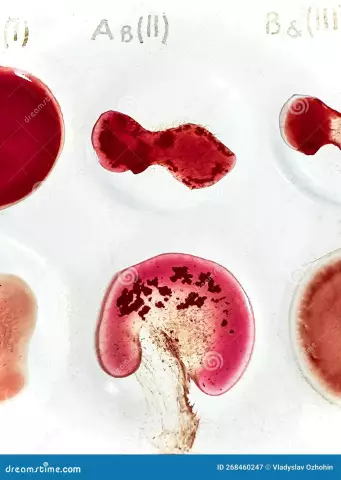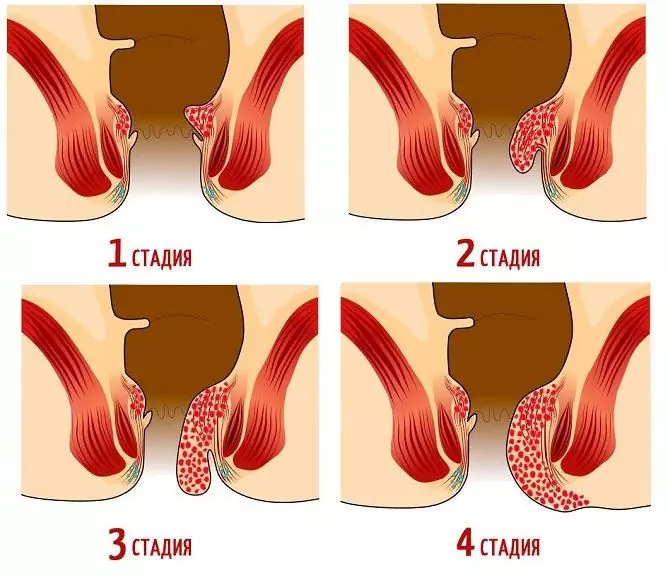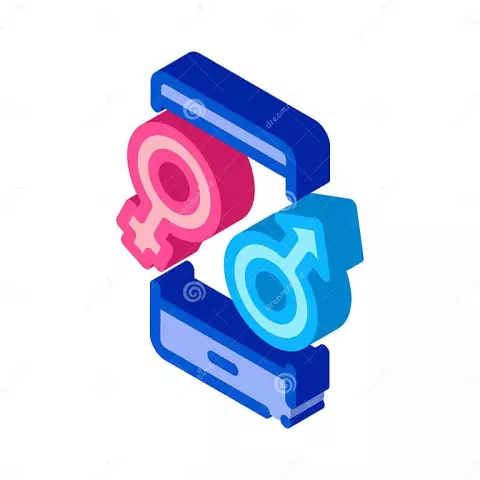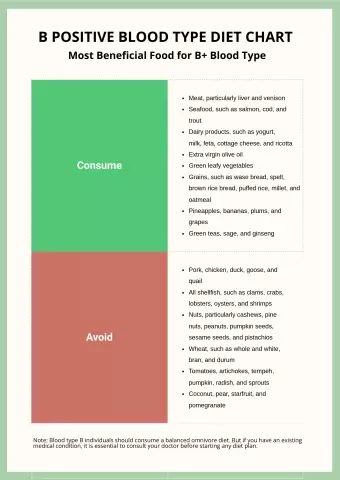- Author Rachel Wainwright [email protected].
- Public 2023-12-15 07:39.
- Last modified 2025-11-02 20:14.
Blood group compatibility

Blood is the internal environment of the body, formed by liquid connective tissue. Blood consists of plasma and corpuscles: leukocytes, erythrocytes and platelets. Blood group - the composition of certain antigenic characteristics of erythrocytes, which are determined by identifying specific groups of proteins and carbohydrates that make up the membranes of erythrocytes. There are several classifications of human blood groups, the most significant among which are the AB0 classification and the Rh factor. Human blood plasma contains agglutinins (α and β), human erythrocytes contain agglutinogens (A and B). Moreover, only one of proteins A and α in the blood can be contained, as well as from proteins B and β. Thus, only 4 combinations are possible, which determine a person's blood group:
- α and β define 1 blood group (0);
- A and β define 2 blood group (A);
- α and B define 3 blood group (B);
- A and B define the 4th blood group (AB).
Rh factor is a specific antigen (D) located on the surface of erythrocytes. The widely used terms "Rh", "Rh-positive" and "Rh-negative" refer specifically to the D-antigen and explain its presence or absence in the human body. Blood group compatibility and Rh compatibility are key concepts that are the individual identifiers of a person's blood.
Blood group compatibility
The theory of blood group compatibility arose in the middle of the 20th century. Hemotransfusion (blood transfusion) is used to restore the volume of circulating blood in the human body, replace its components (erythrocytes, leukocytes, plasma proteins), to restore osmotic pressure, with aplasia of hematopoiesis, infections, burns. The transfused blood must be compatible both in group and in Rh factor. The compatibility of blood groups is determined by the main rule: the donor's erythrocytes should not agglutinate with the plasma of the receiving side. So, when the agglutinins and agglutinogens of the same name meet (A and α or B and β), the reaction of sedimentation and subsequent destruction (hemolysis) of erythrocytes begins. As the main mechanism for transporting oxygen in the body, blood stops breathing.
It is believed that the first 0 (I) blood group is universal, which can be transfused into recipients with any other blood group. The fourth blood group AB (IV) is a universal recipient, that is, its owners can be transfused with blood of any other groups. As a rule, in practice, they are guided by the rule of exact compatibility of blood groups, transfusing blood of one group, taking into account the recipient's Rh factor.
1 blood group: compatibility with other groups
Owners of the first blood group 0 (I) Rh- can become donors for all other blood groups 0 (I) Rh +/-, A (II) Rh +/-, B (III) Rh +/-, AB (IV) Rh +/-. In medicine, it was customary to talk about a universal donor. In the case of donation of 0 (I) Rh +, the following blood groups can become its recipients: 0 (I) Rh +, A (II) Rh +, B (III) Rh +, AB (IV) Rh +.
Currently, 1 blood group, the compatibility of which with all other blood groups has been proven, is used for blood transfusion to recipients with a different blood group in extremely rare cases in volumes of no more than 500 ml. For recipients with blood group 1, compatibility will be as follows:
- at Rh +, both 0 (I) Rh- and 0 (I) Rh + can become a donor;
- at Rh- only 0 (I) Rh- can become a donor.
2 blood group: compatibility with other groups
Blood group 2, the compatibility of which with other blood groups is very limited, can be transfused into recipients with A (II) Rh +/- and AB (IV) Rh +/- in the case of a negative Rh factor. In the case of a positive Rh factor Rh + of group A (II), it can only be transfused into recipients A (II) Rh + and AB (IV) Rh +. For owners of 2 blood groups, compatibility is as follows:
- with own A (II) Rh +, the recipient can receive the first 0 (I) Rh +/- and the second A (II) Rh +/-;
- with own A (II) Rh- the recipient can receive only 0 (I) Rh- and A (II) Rh-.
Blood group 3: transfusion compatibility with other blood groups
If the donor is the owner of blood group 3, the compatibility will be as follows:
- with Rh +, B (III) Rh + (third positive) and AB (IV) Rh + (fourth positive) become recipients;
- with Rh-, B (III) Rh +/- and AB (IV) Rh +/- become recipients.
If the recipient is the owner of blood group 3, the compatibility will be as follows:

- with Rh + donors can be 0 (I) Rh +/-, as well as B (III) Rh +/-;
- with Rh- donors can become owners of 0 (I) Rh- and B (III) Rh-.
4 blood group: compatibility with other groups
Holders of 4 positive blood groups AB (IV) Rh + are called universal recipients. So, if the recipient has blood group 4, the compatibility will be as follows:
- with Rh + donors can be 0 (I) Rh +/-, A (II) Rh +/-, B (III) Rh +/-, AB (IV) Rh +/-;
- with Rh- donors can be 0 (I) Rh-, A (II) Rh-, B (III) Rh-, AB (IV) Rh-.
A slightly different situation is observed when the donor has blood group 4, the compatibility will be as follows:
- with Rh +, the recipient can only be one AB (IV) Rh +;
- with Rh-, owners of AB (IV) Rh + and AB (IV) Rh- can become recipients.
Blood group compatibility for conceiving a child
One of the key values of the compatibility of blood groups and Rh factors is conceiving a child and carrying a pregnancy. Blood group compatibility of partners does not affect the likelihood of conceiving a child. The compatibility of blood groups for conception is not as important as the compatibility of Rh factors. This is due to the fact that when an antigen (Rh factor) enters an organism that does not have it (Rh negative), an immunological reaction begins, in which the recipient's body begins to produce agglutinins (degrading proteins) to the Rh factor. When Rh-positive erythrocytes re-enter the blood of a Rh-negative recipient, agglutination (sticking) and hemolysis (destruction) of the resulting erythrocytes occur.
Rh-conflict - the incompatibility of the blood groups of the Rh-negative Rh- mother and the Rh + fetus, as a result of which the breakdown of red blood cells in the child's body occurs. The baby's blood, as a rule, enters the mother's body only during childbirth. The production of agglutinins to the child's antigen during the first pregnancy occurs rather slowly, and by the end of pregnancy does not reach a critical value that is dangerous for the fetus, which makes the first pregnancy safe for the child. Rh-conflict states during the second pregnancy, when agglutinins are preserved in the mother's Rh-body, are manifested by the development of hemolytic disease. After the first pregnancy, Rh-negative women are recommended to administer anti-Rhesus globulin in order to break the immunological chain and stop the production of anti-Rhesus bodies.
YouTube video related to the article:
Found a mistake in the text? Select it and press Ctrl + Enter.






